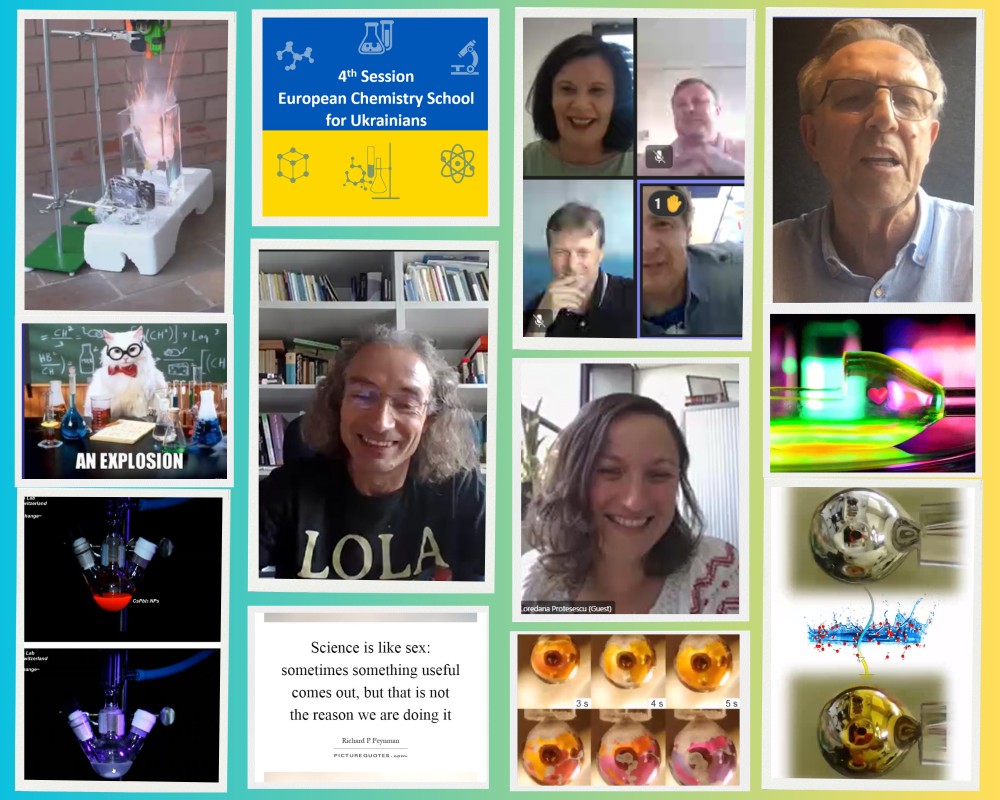European Chemistry School for Ukrainians
4th Session June 15th 2023
The fourth session of the European Chemistry School for Ukrainians welcomed Prof. Dr. Eugenio Coronado of the University of Valencia, Prof. Dr. Pavel Jungwirth of the Czech Academy of Sciences, and Prof. Dr. Loredana Protesescu of the University of Groningen.
Prof. Dr. Coronado, Director of the Institute of Molecular Science (ICMol) at the University of Valencia and European Institute of Molecular Magnetism, shared his work on low dimensional magnetic materials. Prof. Coronado began by explaining how he works to make materials that are increasingly complex and functional by transforming basic monolayers to multilayer Van de Waals heterostructures to hybrid materials – specifically magnetic materials. His work faces challenges at every stage of development: the separation of monolayers, the inherent instability of large crystals, the intricacies required to measure magnetism in 2D planes, and of course the stubbornness with which increasingly complex materials become decreasingly homogeneous. His team has found ways to meet all of these challenges, patiently performing exfoliations and experimenting with protective layers to coat their samples. This work has made it possible for the Coronado team to demonstrate how spin-crossover effects can explain electrical and optical properties of materials, laying the foundation for smart 2D devices.
When asked about what advice he had for young researchers, Coronado promoted his uniquely interdisciplinary research style, telling the audience to “choose a topic between fields that are not well connected” but that have potential to contribute to each other, and define their own field by working on the possibilities at their interface. There is no need for nor satisfaction in following the trends of overpopulated fields.
Prof. Coronado’s talk was interrupted by a flurry on messages on the chat – two air raid sirens were sounded in Kyiv; some of the audience members left to take shelter. Hearing the update from the organizers, Coronado was quick to address the war: “From the outside, it is always easy to say “we hope…” Coronado lamented, but “I am with you.”
Prof. Dr. Jungwirth opened his lecture with a satisfying video of an explosion in the California desert: sodium metal being thrown into a vat of water by a particularly adventurous American collaborator. This dramatic opening introduced the audience to one of Jungwirth’s research interests: solvated electrons. Chemists generally only encounter solvated electrons in the lab during birch reductions, and the process of solvated electron evolution was not well studied until the Jungwirth team made it their mission to understand it. At the end of a journey that involved hedgehog-evoking solvent spikes, columbic explosions, Raleigh cones, the Leidenfrost Effect (inverted, of course), a synchrotron, misleading a camera rental agency, a lot of liquid ammonia, and at least one nerf gun, the Jungwirth Group produced and published an explanation of the stages of electron solvation (and a very lovely holiday-appropriate video of the “Golden Metallic State” of the process set to comforting music).
But “What is metallic water good for?” Prof. Jungwirth asked his audience: “Because we are doing science to help mankind!” Science should be driven by curiosity, not application, Jungwirth insisted. Fundamental studies like these, he explained, elevate the state of the art even (or especially) if they are not immediately ¢useful¢.
After taking the last question, Jungwirth set an appointment with the audience for the future: “After Ukraine wins the war, I am looking forward to going to a conference in Ukraine.”
Prof. Dr. Loredana Protesescu gave the final presentation, joining the school from the University of Groningen in the Netherlands. The Protesescu Group studies a wide range of materials: quantum dots, perovskites, metal borides, and metal-organic frameworks in pursuit of new, functional materials designed to address specific needs in industry and society. Nanocrystals, Prof. Protesescu noted, are like bricks used to build a house- they can be arranged in many different patterns to form any number of unique structures serving a variety of different purposes. Protesescu’s research focuses on ways to make the best possible building bricks and assemble them into useable structures.
Prof. Protesescu’s projections of the future included her views on new methodology and new goals. Machine learning, Prosescu predicts, will play a huge role in the development of new materials, especially new crystal structures. Computer learning can organize unpublished data from “failed” experiments and identify trends in ways that human scientists, limited by time, cannot. “We are repeating the same mistakes all the time,” Protesescu said. Protesescu also predicted that the focus of materials science will shift to emphasize the development of “super hard materials,” materials that are impermeable or at least resistant to heat, corrosion, radiation, and other stresses. These, she suspects, will define the future of electronic devices.
Before leaving, Protesescu encouraged the audience members to consider the University of Groningen. Her university nurtures a particularly accomplished masters degree program and offers scholarship to “students from everywhere.” She gave examples of students who have flourished at her school, such as a masters student who founded a company to develop new X-ray technology with quantum dots.
One of the first questions Prof. Protesescu received was about her key to success as not only an accomplished and productive scientist but as a mother in her male dominated field. She replied with inspiring honesty, “You can have a family. You can have a career. When it’s hard, only the passion for what you do keeps you going.”
Written by Madeline Walden
Photo Collage by Orysia Zaremba



